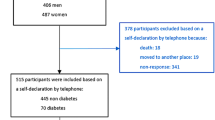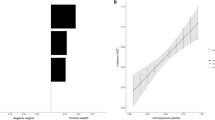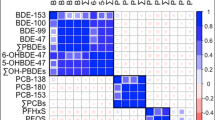Abstract
Epidemiological studies have suggested a link between exposure to persistent organic pollutants (POPs) and hypertension. Cross-sectional associations of serum POP concentrations with the prevalence of newly diagnosed hypertension were investigated in 524 adult participants aged ⩾40 years in the National Health and Nutrition Examination Survey 1999–2002. Twenty-one POPs (three polychlorinated dibenzo-p-dioxins (PCDDs), three polychlorinated dibenzofurans (PCDFs), five dioxin-like polychlorinated biphenyls (PCBs), six dioxin-unlike PCBs and four organochlorine (OC) pesticides) were selected because they were detectable in ⩾60% of participants. Serum concentrations of PCDDs and PCDFs were associated with prevalent but newly diagnosed hypertension among women, but not among men. Across quartiles of the sum of category numbers of the three PCDDs and the three PCDFs, adjusted odds ratios in women were 1.0, 4.2 (95% confidence interval (CI): 1.0–17.1), 4.5 (1.0–19.9) and 5.0 (1.2–21.5) (P for trend=0.08) and 1.0, 2.6 (0.8–9.0), 5.9 (1.7–20.0) and 4.2 (1.3–14.3) (P for trend=0.01), respectively. On the other hand, PCBs tended toward positive association with hypertension only among men. Adjusted odds ratios in men in the highest quartiles of the sum of category numbers of the dioxin-like and non-dioxin-like PCBs were 2.3 (0.8–6.6) and 2.8 (0.9–8.5) (P for trend=0.11 or 0.04), respectively. OC pesticides were not clearly associated with hypertension in either gender. Hypertension had gender-specific associations with serum concentrations of some POPs. Considering the common presence of exposure to POPs in the general population, these findings need to be clarified in prospective studies.
This is a preview of subscription content, access via your institution
Access options
Subscribe to this journal
Receive 12 digital issues and online access to articles
$119.00 per year
only $9.92 per issue
Buy this article
- Purchase on Springer Link
- Instant access to full article PDF
Prices may be subject to local taxes which are calculated during checkout
Similar content being viewed by others
References
Van den Berg M, Birnbaum L, Bosveld AT, Brunstrom B, Cook P, Feeley M et al. Toxic equivalency factors (TEFs) for PCBs, PCDDs, PCDFs for humans and wildlife. Environ Health Perspect 1998; 106: 775–792.
Lee DH, Lee IK, Song K, Steffes M, Toscano W, Baker BA et al. A strong dose–response relation between serum concentrations of persistent organic pollutants and diabetes: results from the National Health and Examination Survey 1999–2002. Diabetes Care 2006; 29: 1638–1644.
Lee DH, Lee IK, Porta M, Steffes M, Jacobs Jr DR . Relationship between serum concentrations of persistent organic pollutants and the prevalence of metabolic syndrome among non-diabetic adults: results from the National Health and Nutrition Examination Survey 1999–2002. Diabetologia 2007; 50: 1841–1851.
Ha MH, Lee DH, Jacobs DR . Association between serum concentrations of persistent organic pollutants and self-reported cardiovascular disease prevalence: results from the National Health and Nutrition Examination Survey, 1999–2002. Environ Health Perspect 2007; 115: 1204–1209.
Sandifer SH, Keil JE, Finklea JF, Gadsden RH . Pesticide effects on occupationally exposed workers: a summary of four years observation of industry and farm volunteers in South Carolina. IMS Ind Med Surg 1972; 41: 9–12.
Morgan DP, Lin LI, Saikaly HH . Morbidity and mortality in workers occupationally exposed to pesticides. Arch Environ Contam Toxicol 1980; 9: 349–382.
Wassermann M, Bercovici B, Cucos S, Wassermann D, Ron M . Storage of some organochlorine compounds in toxemia of pregnancy. Environ Res 1980; 22: 404–411.
Kreiss K, Zack MM, Kimbrough RD, Needham LL, Smrek AL, Jones BT . Association of blood pressure and polychlorinated biphenyl levels. JAMA 1981; 245: 2505–2509.
Pesatori AC, Zocchetti C, Guercilena S, Consonni D, Turrini D, Bertazzi PA . Dioxin exposure and non-malignant health effects: a mortality study. Occup Environ Med 1998; 55: 126–131.
Huang X, Lessner L, Carpenter DO . Exposure to persistent organic pollutants and hypertensive disease. Environ Res 2006; 102: 101–106.
Akagi K, Okumura M . Association of blood pressure and PCB level in Yusho patients. Environ Health Perspect 1985; 59: 37–39.
Stehr-Green PA, Welty E, Steele G, Steinberg K . Evaluation of potential health effects associated with serum polychlorinated biphenyl levels. Environ Health Perspect 1986; 70: 255–259.
Crews D, Willingham E, Skipper JK . Endocrine disruptors: present issues, future directions. Q Rev Biol 2000; 75 (3): 243–260.
NHANES 1999–2000 Public Data Release File Documentation, 2005. http://www.cdc.gov/nchs/about/major/nhanes/nhanes01-02.htm.
NHANES 2000–2001 Public Data Release File Documentation, 2005. http://www.cdc.gov/nchs/about/major/nhanes/nhanes01-02.htm.
CDC (Centers for Disease Control and Prevention). Third National Report on Human Exposure to Environmental Chemicals, 2005. http://www.cdc.gov/exposurereport/3rd/pdf/thirdreport.pdf.
Perloff D, Grim C, Flack J, Frohlich ED, Hill M, McDonald M, et al. Human blood pressure determination by sphygmomanometry. Circulation 1993; 88 (5 Part 1): 2460–2470.
Turner W, DiPietro E, Lapeza C, Green V, Gill J, Patterson DJ . A fast universal automated cleanup system for the isotope-dilution HRMS analysis of PCDDs, PCDFs, coplanar PCBs, PCB congeners, and persistent pesticides from the same serum sample. Organohalogen Comp 1997; 31: 26–31.
Korn EL, Graubard BI . Epidemiologic studies utilizing surveys: accounting for the sampling design. Am J Public Health 1991; 81: 1166–1173.
Graubard BI, Korn EL . Analyzing health surveys for cancer-related objectives. J Natl Cancer Inst 1999; 91: 1005–1016.
Chevrier J, Dewailly E, Ayotte P, Mauriege P, Despres JP, Tremblay A . Body weight loss increases plasma and adipose tissue concentrations of potentially toxic pollutants in obese individuals. Int J Obes Relat Metab Disord 2000; 24: 1272–1278.
Wolff MS, Britton JA, Teitelbaum SL, Eng S, Deych E, Ireland K et al. Improving organochlorine biomarker models for cancer research. Cancer Epidemiol Biomarkers Prev 2005; 14: 2224–2236.
Au WW . Susceptibility of children to environmental toxic substances. Int J Hyg Environ Health 2002; 205: 501–503.
Lee DH, Jacobs Jr DR, Porta M . Could low-level background exposure to persistent organic pollutants contribute to the social burden of type 2 diabetes? J Epidemiol Community Health 2006; 60: 1006–1008.
Enan E, Overstreet JW, Matsumura F, VandeVoort CA, Lasley BL . Gender differences in the mechanism of dioxin toxicity in rodents and in nonhuman primates. Reprod Toxicol 1996; 10: 401–411.
Wyde ME, Wong VA, Kim AH, Lucier GW, Walker NJ . Induction of hepatic 8-oxo-deoxyguanosine adducts by 2,3,7,8-tetrachlorodibenzo-p-dioxin in Sprague–Dawley rats is female-specific and estrogen-dependent. Chem Res Toxicol 2001; 14: 849–855.
Lind PM, Orberg J, Edlund UB, Sjoblom L, Lind L . The dioxin-like pollutant PCB 126 (3,3′,4,4′,5-pentachlorobiphenyl) affects risk factors for cardiovascular disease in female rats. Toxicol Lett 2004; 150: 293–299.
Sowers JR . Diabetes mellitus and cardiovascular disease in women. Arch Intern Med 1998; 158: 617–621.
Safe S, Wang F, Porter W, Duan R, McDougal A . Ah receptor agonists as endocrine disruptors: antiestrogenic activity and mechanisms. Toxicol Lett 1998; 102–103: 343–347.
Wang SL, Chang YC, Chao HR, Li CM, Li LA, Lin LY et al. Body burdens of polychlorinated dibenzo-p-dioxins, dibenzofurans, and biphenyls and their relations to estrogen metabolism in pregnant women. Environ Health Perspect 2006; 114: 740–745.
Daston GP, Cook JC, Kavlock RJ . Uncertainties for endocrine disrupters: our view on progress. Toxicol Sci 2003; 74: 245–252.
Bannister R, Davis D, Zacharewski T, Tizard I, Safe S . Aroclor 1254 as a 2,3,7,8-tetrachlorodibenzo-p-dioxin antagonist: effects on enzyme induction and immunotoxicity. Toxicology 1987; 46: 29–42.
Davis D, Safe S . Dose–response immunotoxicities of commercial polychlorinated biphenyls (PCBs) and their interaction with 2,3,7,8-tetrachlorodibenzo-p-dioxin. Toxicol Lett 1989; 48: 35–43.
Schisterman EF, Whitcomb BW, Louis GM, Louis TA . Lipid adjustment in the analysis of environmental contaminants and human health risks. Environ Health Perspect 2005; 113: 853–857.
Author information
Authors and Affiliations
Corresponding author
Rights and permissions
About this article
Cite this article
Ha, MH., Lee, DH., Son, HK. et al. Association between serum concentrations of persistent organic pollutants and prevalence of newly diagnosed hypertension: results from the National Health and Nutrition Examination Survey 1999–2002. J Hum Hypertens 23, 274–286 (2009). https://doi.org/10.1038/jhh.2008.124
Received:
Revised:
Accepted:
Published:
Issue Date:
DOI: https://doi.org/10.1038/jhh.2008.124
Keywords
This article is cited by
-
Combined exposure to multiple dioxins and dioxin-like polychlorinated biphenyls on hypertension among US adults in NHANES: a cross-sectional study under three statistical models
Environmental Science and Pollution Research (2022)
-
The Health Status of Hispanic Agricultural Workers in Georgia and Florida
Journal of Immigrant and Minority Health (2022)
-
A Systematic Review of Environmental Health Outcomes in Selected American Indian and Alaska Native Populations
Journal of Racial and Ethnic Health Disparities (2020)
-
Echoes from Gaea, Poseidon, Hephaestus, and Prometheus: environmental risk factors for high blood pressure
Journal of Human Hypertension (2018)
-
Association of serum concentrations of persistent organic pollutants (POPs) and risk of pre-eclampsia: a case–control study
Journal of Environmental Health Science and Engineering (2016)



